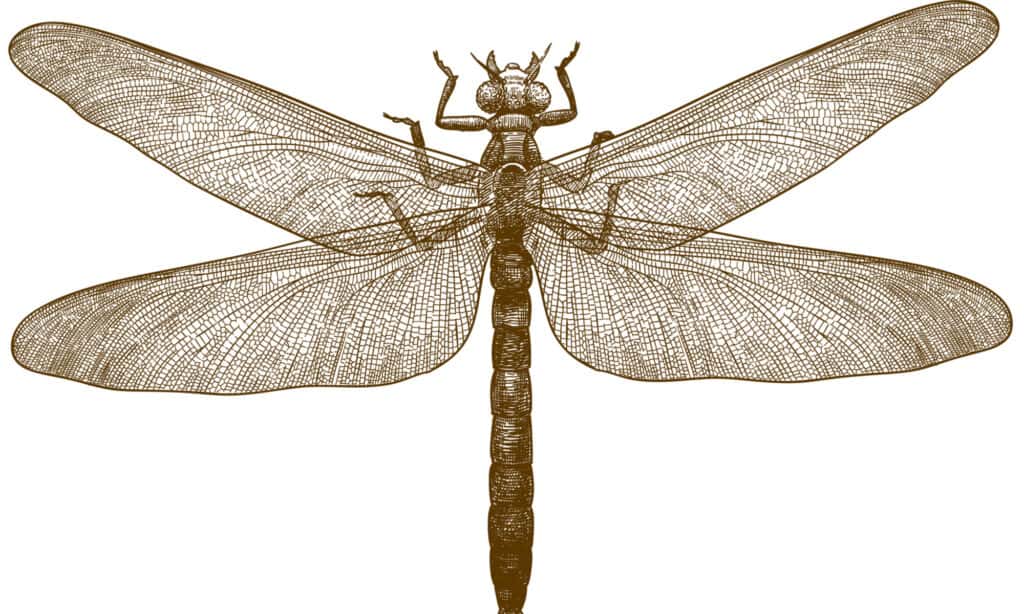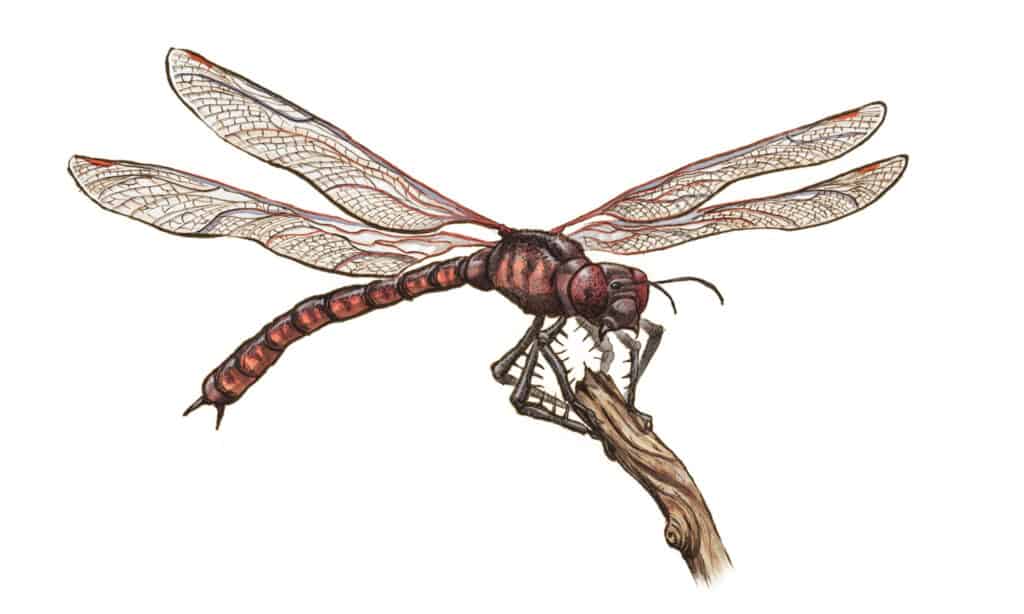Dragonflies were among the first insects on earth about 300 million years ago. Over the millennia, these insects have developed an extraordinary art of flying and hunting for survival. Their backward flying technique helps to catch flying prey. While most dragonflies are known to feed on other insects, the giant dragonfly, the Meganeura dragonfly, is the strongest that ever lived and could feed on lizards!
The giant dragonfly (Meganeura) belongs to a genus of huge dragonflies dating back to the carboniferous age. These rare insects were strong enough to catch and feed on lizards and other small animals.
Though always associated with the modern-day dragonflies due to their appearance, considering the various structural and other characteristics between them, these insects were often classified as griffinflies.
Here is more about the Giant dragonfly, its life span, habitat, and diet. You will also find out about any predators of this extraordinary insect.
The Giant Dragonfly Description
The name Meganeura means “large-veined” to denote the similarities of the veins on the wings of this insect. A mature falcon-sized dragonfly was about 17 inches long. These dragonflies are easy to identify. The following are distinguishing features of the Giant dragonfly:
- It had a wingspan of 28 inches, with each wing being 13 inches long.
- All giant dragonflies had similar veins on their wings, unlike the present-day dragonflies, which have varying wing veins.
- They had large eyes to enable them to spy on their prey.
- Their legs had spines to help them hold their prey.
- They had powerful jaws that allowed them to attack their aquatic prey.
- They had a pair of powerful mandibles with a tooth to hold large and struggling creatures.
- Their segmented bodies were brownish-black with yellow marks throughout the back sides.

All giant dragonflies had similar veins on their wings, unlike the present-day dragonflies, which have varying wing veins.
©andrey oleynik/Shutterstock.com
What Did Giant Dragonflies Eat?
These insects mainly dwelt around water bodies like lakes, streams, and ponds and relied on aquatic food. They were carnivorous insects, especially feeding on other insects, small reptiles, and amphibians. It was an incredible aerial predator with powerful mandibles and arms to catch and tear prey apart. They were well-known for their ability to eat their prey while still on the wing. The diet of the giant dragonfly is rare among all the insects in today’s ecology.
Habitat
Giant dragonflies lived mostly in bogs and permanent swamps with open vegetation and free water. Mature ones were short-lived, appearing in late October and surviving only one summer before disappearing. Most of their time was spent hiding in the lower vegetation near the swamps. The first of these insects lived in the enormous warm equatorial forests. During that time, these forests covered the central parts of France.
Fossil remains indicate that these dragonflies lived during the carboniferous era, about 359 to 299 million years ago. Experts link the size of these insects to the amount of oxygen in the atmosphere, which is about twice as much as today.
Charles Brongniart described the giant dragonfly in 1885, shortly after discovering its fossils in Commentry City, in the Auvergne region. It was ranked the enormous giant insect of the Paleozoic era until the 20th century when Meganeuridae was found in the United States. The remains of the Meganeuridae show that it was larger than the giant dragonfly by a few centimeters.
Was the Giant Dragonfly the “Hawk” in the Paleozoic Period?
Giant dragonflies can be categorized as “hunters in-flight” compared to the present-day dragonflies, making them the Paleozoic “hawks.” The dragonflies of today display two types of hunting techniques: perched hunting and flight (hawk) hunting.
The fossils of these ancient dragonflies show the following features of a “hawk” hunter:
- They had large, contiguous compound eyes that would spot prey from a distance.
- They had spiky solid legs for seizing prey.
They were the greatest sky predators of the Paleozoic era until the arrival of the gliding reptiles at the end of the Permian.

Meganeura had spiky solid legs for seizing prey.
©Filippo Vanzo/Shutterstock.com
Threats and Predators
There is only one giant dragonfly predator documented in history, the Petrolacosaurus. It was a small reptile resembling the modern-day lizard. These reptiles would hunt on the floors of the carboniferous forest for small insects.
They appeared around 230 million years ago and posed a more significant threat to the giant dragonflies because they could also fly. They took advantage of forest fires to hunt the giant dragonflies that flew around the fire desperately. However, it was still not easy for them to match the flying speed of the Falcon-sized dragonflies; most of them would escape.
The evolution of birds started posing a threat to the existence of the giant dragonflies and other insects in the Paleozoic skies. The biggest threat came from the drop in oxygen levels in the atmosphere, making it hard for big insects to breathe. The low oxygen was too insufficient for the enormous insects to take in through the tiny pores that acted as lungs.
Discoveries of Giant Dragonfly Fossils
Fossils confirming the existence of giant dragonflies 300 million years ago have been discovered in several places. The first giant dragonfly fossils were discovered in 1880 in France, where these insects are believed to have lived. Charles Brongniart, a French paleontologist, studied, described, and gave this fossil its name in 1885.
In 1979, other remains were discovered by scientists in Bolsover, Derbyshire. Other giant dragonfly fossils were discovered in Jharkhand’s Latehar district in India. A group of West Bengal scientists found it. The fossil is about two and a half million years old. The dragonfly from this fossil lived about 2.5 to 5 million years ago.
The largest giant dragonfly fossil was discovered in China, with a wingspan of approximately 27.95 inches. Researchers studying this fossil say it existed in the Permian period (280 million years ago).
Beijing, a giant dragonfly fossil, was discovered in China, and it dates back to about 200 million years ago. Paleontologists and geologists in China argue that this particular dragonfly must have lived during the Triassic period. The Triassic period lasted between “251 to 199 million” years ago. Beijing was discovered in 2013 in Junggar Basin, Xinjiang Uygur. It had a smaller wingspan than the first fossil in China (101 mm).
Zhang Haichun, a leading researcher in China, said that dragon fossils are not easy to preserve, but the latest discovery in China is well-preserved. According to the fossil remains, scientists believe that these enormous insects lived from the late carboniferous era to the late Permian period (317 to 247 million years ago).
Extinction of the Giant Dragonflies
The giant dragonfly and other large insects began going extinct during the Permian period (250 million years ago). Some scientists attribute the enormity of the ancient insects to the high oxygen concentration in the atmosphere during the carboniferous period. The gradual change in the earth’s atmosphere during the Permian period led to the decline in atmospheric oxygen resulting in the extinction of many giant insects.
The following are some possible causes of the extinction of the giant dragonflies from the face of the earth:
1. Atmospheric changes
Some scientists theorize that a high oxygen concentration in the atmosphere contributed to the size of these insects. Researchers have directly linked large wingspans and oxygen concentration for more than 10,000 insect fossils living about 320 million years ago.
Many of these insects started declining in numbers in the Permian period with changes in atmospheric conditions and decreased oxygen levels. Their body sizes did not allow them to breathe well with the decreasing oxygen, which threatened their existence.
2. Evolution of Dinosaurs
The evolution of some dinosaur species like the Archaeopteryx, which could fly, posed a significant threat to the giant dragonflies. The first flying dinosaur appeared about 140 million years ago and competed with large birds to prey on giant insects. During this time, the wingspans of many insects started getting smaller.
3. Evolution of Birds
Mathew Clapham links the extinction of giant insects to the evolution of birds around a hundred and fifty million years ago. According to Clapham, oxygen fluctuations were constant. At the end of the Jurassic and the start of the Cretaceous periods, the oxygen concentration was increased in the atmosphere. However, Clapham says that giant dragonflies started decreasing drastically.
When birds started dominating the skies, the giant insects had to adapt to ways to maneuver and escape the predators. They started developing smaller wings as adaptation.
Similar Animals to the Giant Dragonfly
Other giant insects lived around the same time as the giant dragonfly, which displayed close similarities. Below are some similar insects:
- Meganeurites gracilipes: They had a wingspan of 27.56 inches, making the modern-day dragonflies appear like dwarfs. They lived around 250 to 300 million years ago.
- Meganeuropsis permiana: They lived during the same period as Meganeura monyi and had a wingspan of 27.95 inches.
- Meganeurites gracilipes: They were similar to the giant dragonflies with compound eyes and strong jaws that qualified them as “hawk” hunters.
Up Next…
- Dragonfly Lifespan: How Long Do Dragonflies Live?: Giant dragonflies lived extremely short lives – how long do their tiny ancestors live today?
- Are Dragonflies Dangerous?: They are some of the prettiest insects of the animal world. Find out if these enchanting creatures are as dangerous as they are beautiful!
- The 10 Largest Dragonflies In The World: You know about the largest dragonfly ever – discover the other largest dragonflies in the world!
- Dragonfly vs Butterfly: What’s the Difference?: They don’t look alike at first – but if you look closely these two insects share many traits other than their beauty.
The photo featured at the top of this post is © Warpaint/Shutterstock.com
FAQs (Frequently Asked Questions)
When did the Giant Dragonfly live?
Giant dragonflies lived about 300 million years ago and were in existence for almost a hundred and ninety million years.
How big was the Giant Dragonfly?
It was the most significant insect to exist on the face of the earth. It had a 28-inch wingspan, and each wing was 13 inches long. It had a body stretch of 17 inches.
Thank you for reading! Have some feedback for us? Contact the AZ Animals editorial team.






